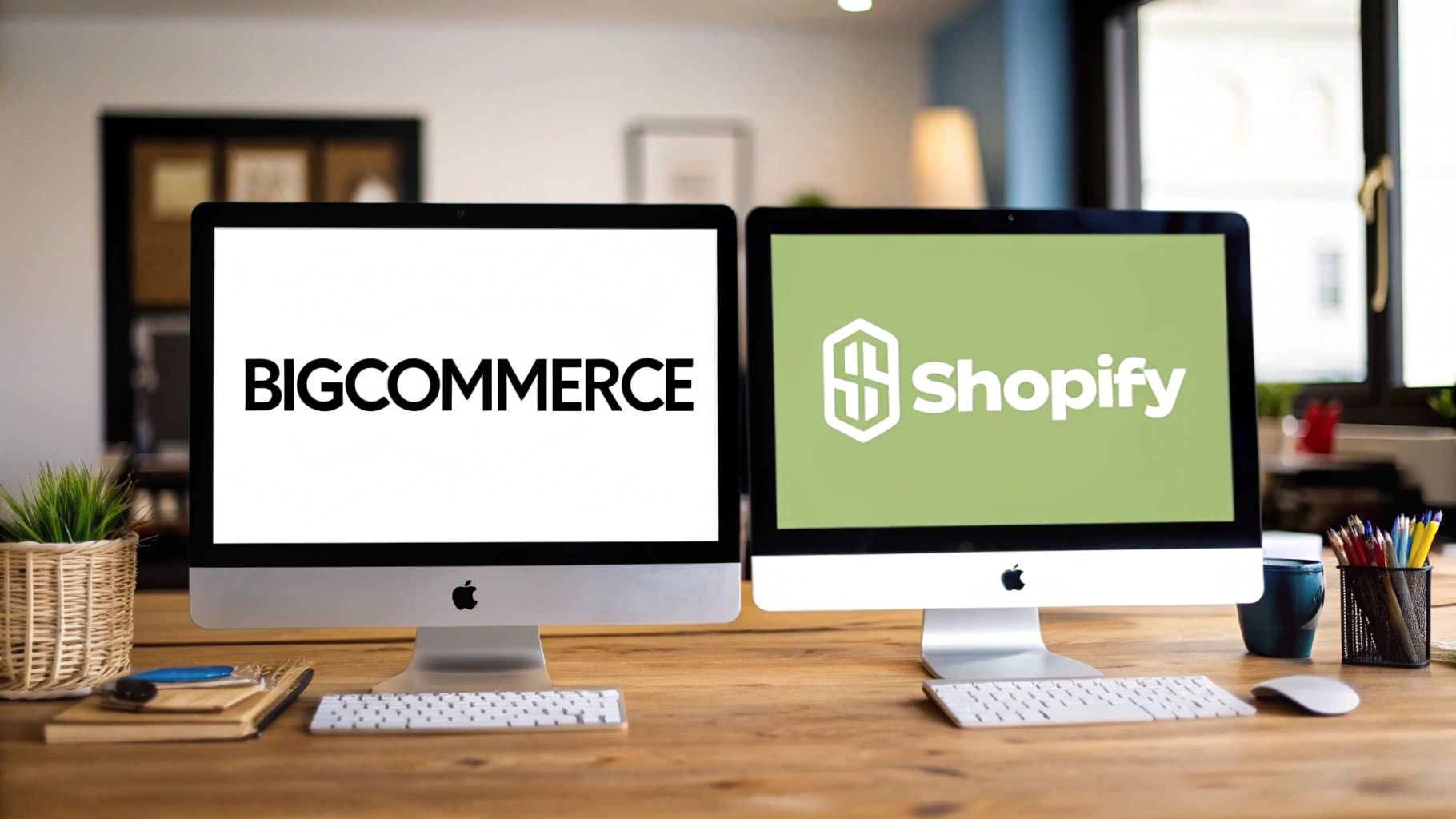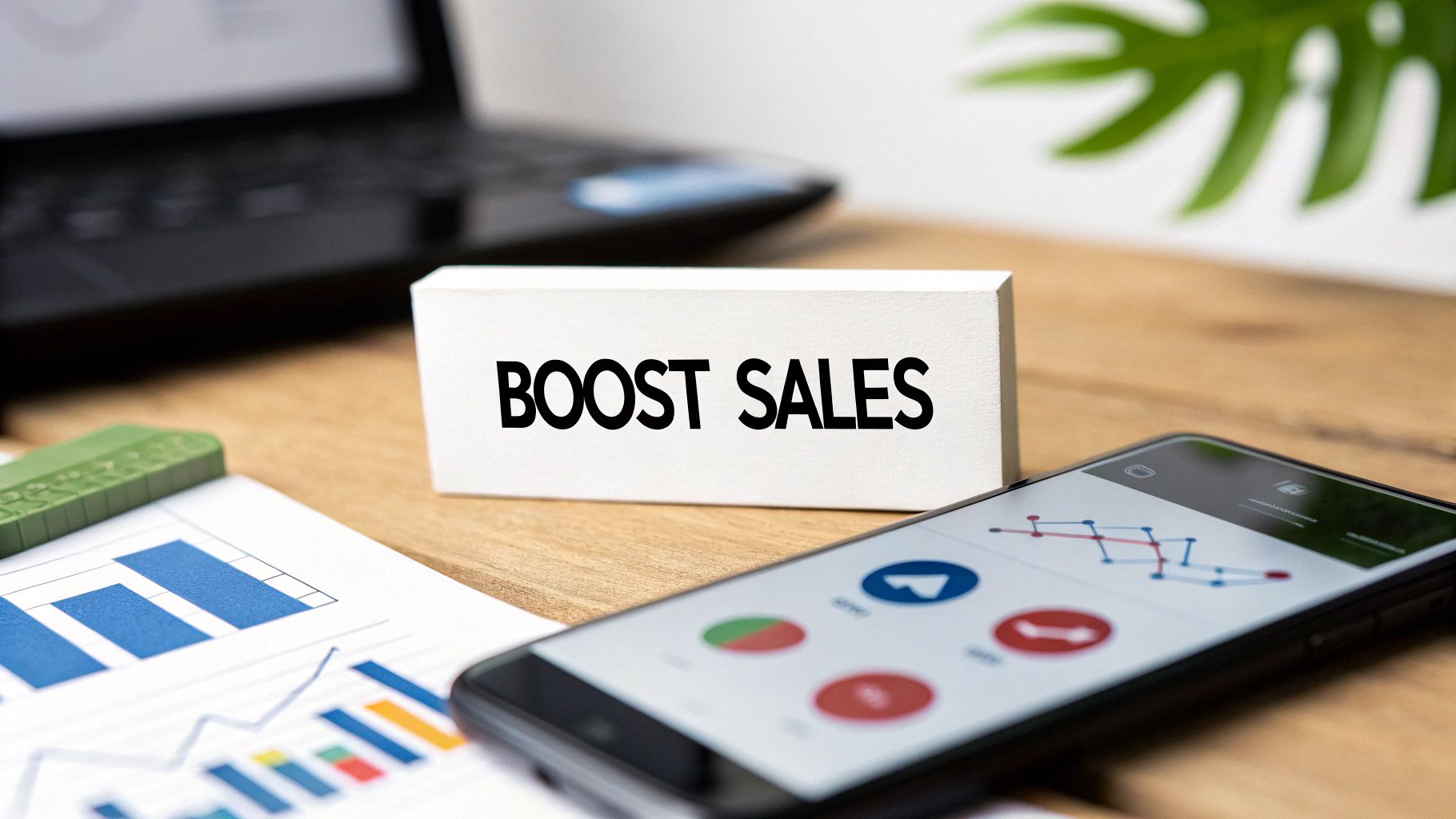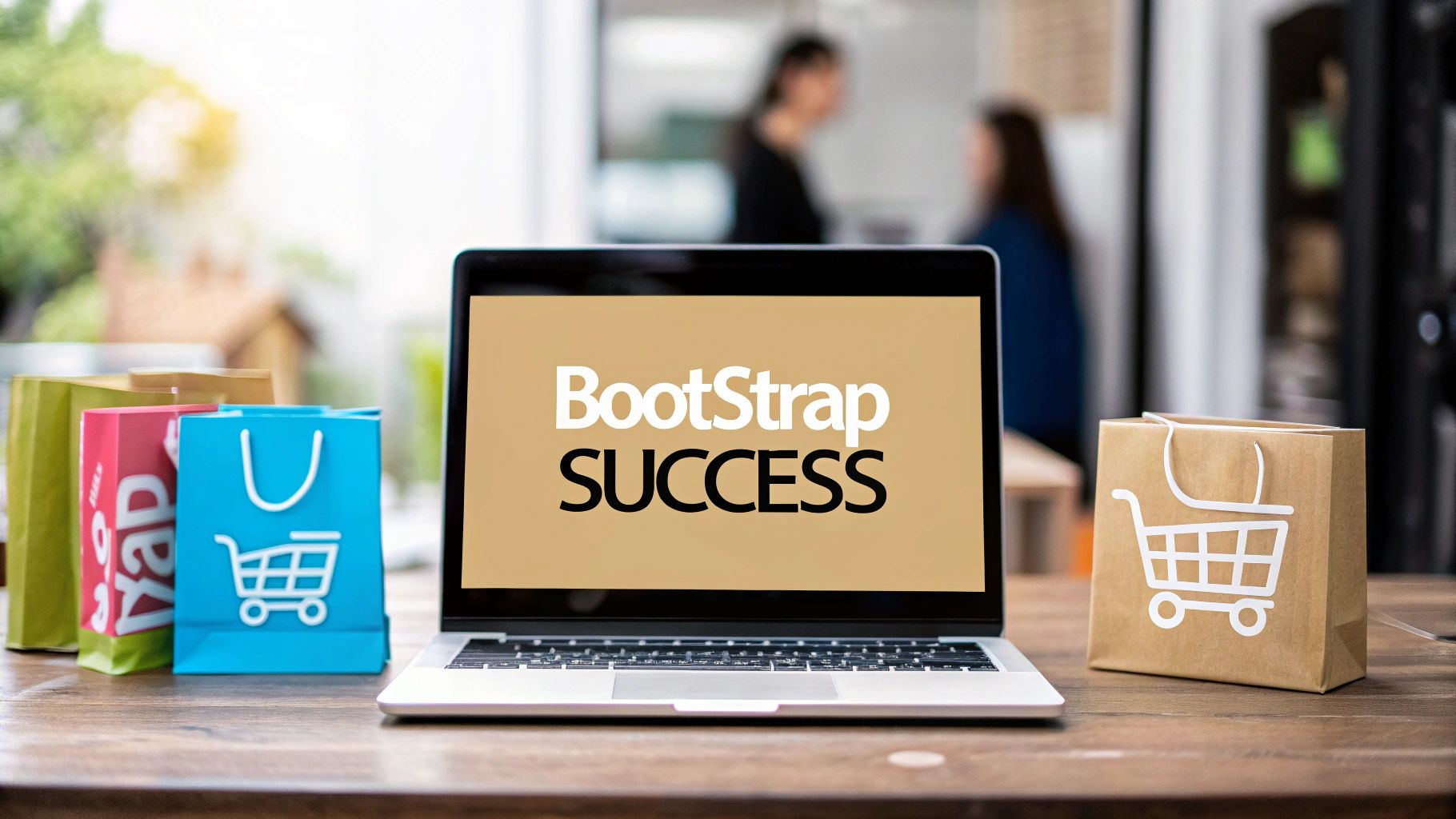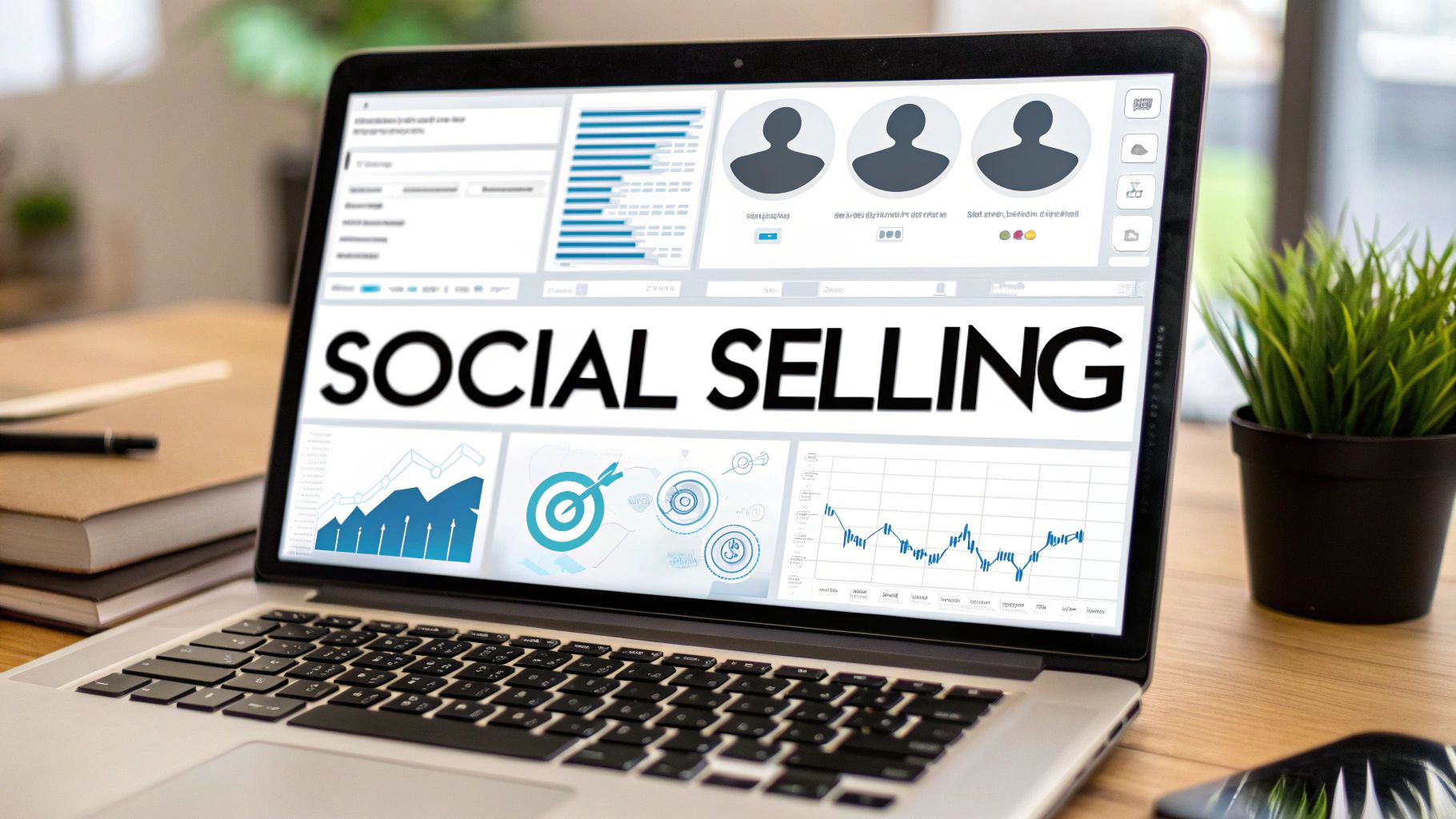How to Drive Traffic to Shopify Store: 8 Proven Strategies
May 22, 2025
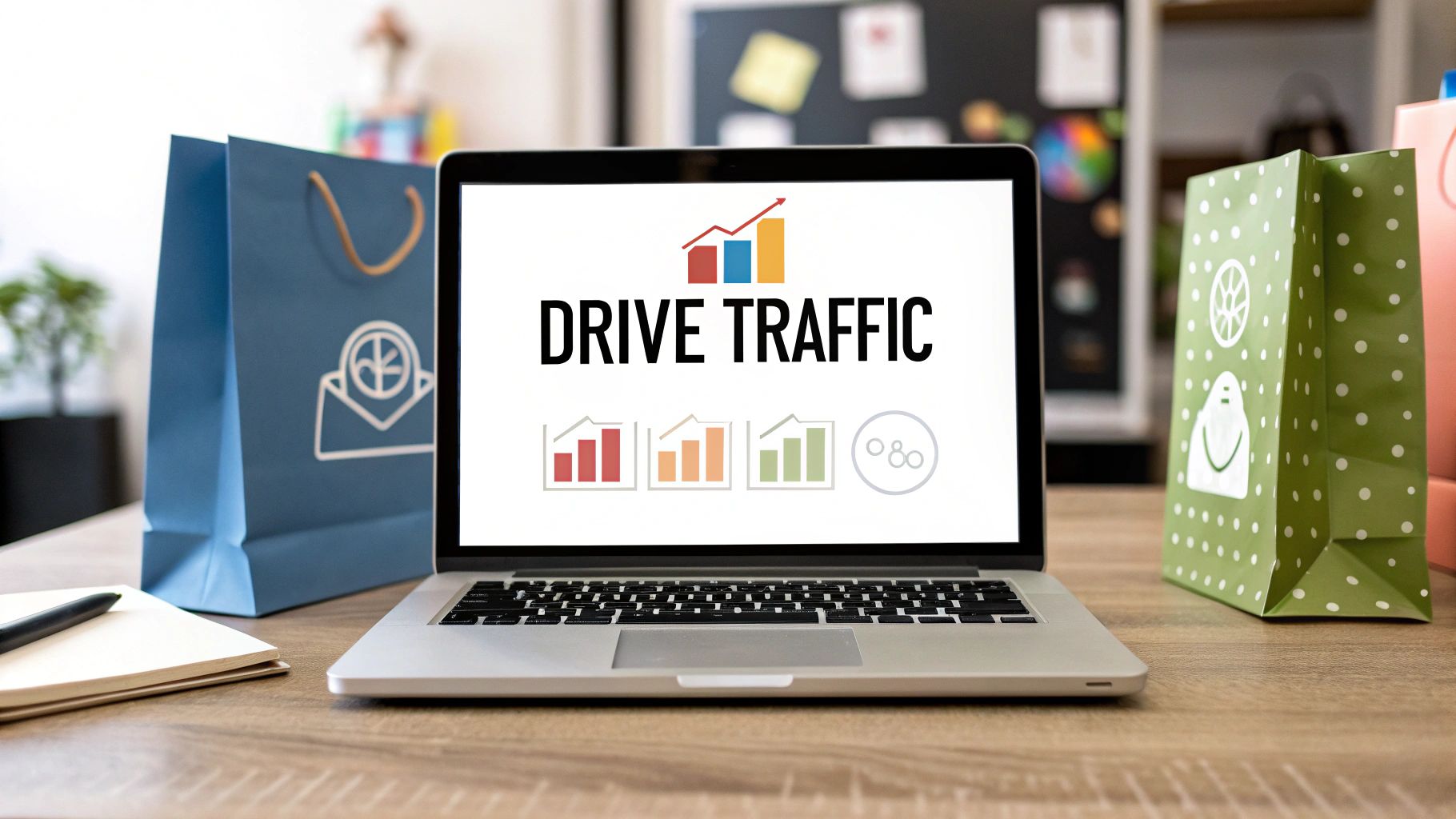
Unlocking Your Store's Potential: A Guide to Traffic Generation
Want to know how to drive traffic to your Shopify store? This guide provides eight proven strategies to boost your store's visibility and attract customers. Learn how search engine optimization (SEO), social media marketing, PPC advertising, email marketing, content marketing, influencer marketing, conversion rate optimization (CRO), and affiliate marketing can help you reach more potential buyers and increase sales. These techniques are crucial for online success because they help your store stand out, connect with your target audience, and ultimately drive more sales.
1. Search Engine Optimization (SEO)
Search Engine Optimization (SEO) is the cornerstone of driving sustainable, long-term traffic to your Shopify store. It's the process of optimizing your online store to rank higher in search engine results pages (SERPs), like Google, when potential customers search for products you offer. Essentially, it's about making your store more visible to the right people. This involves a multi-faceted approach encompassing on-page optimization (making your website content search-engine friendly), technical SEO (improving your website's infrastructure for search engines), and off-page SEO (building your website's authority through backlinks from other reputable sites). By strategically implementing SEO tactics, you can attract customers actively searching for what you sell, leading to higher conversion rates compared to other traffic generation methods.
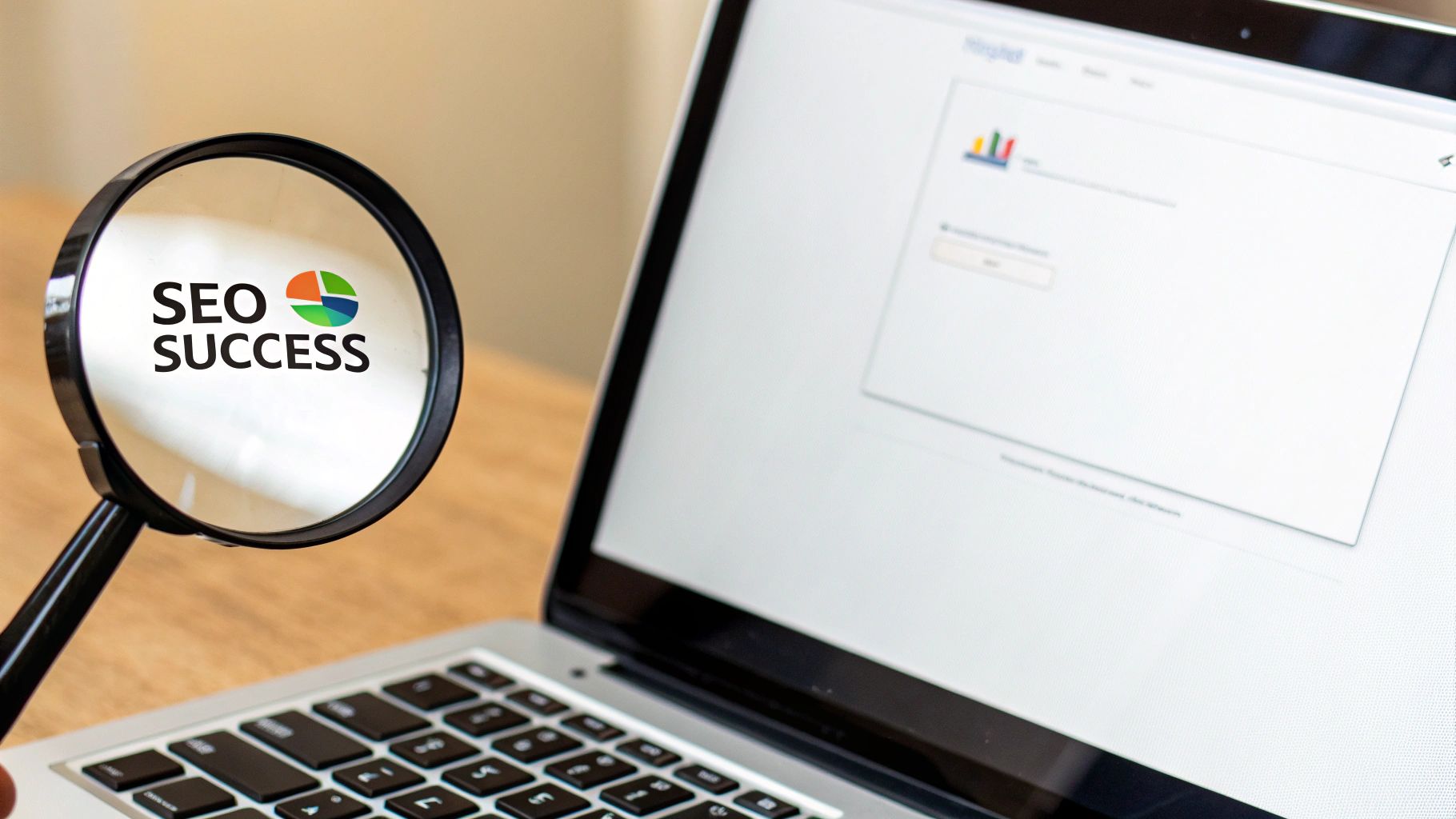
SEO relies on understanding what your target audience searches for and incorporating those keywords (search terms) into your website's content. This includes optimizing product descriptions, creating blog posts around relevant topics, and building a website structure that is easy for both search engines and users to navigate. For instance, think about the keywords someone might use to find your products. Are they searching for "men's running shoes" or "best sustainable sneakers"? Identifying these keywords and strategically using them on your site is crucial for driving organic traffic. Learn more about Search Engine Optimization (SEO) to delve deeper into the core concepts.
Several brands have effectively leveraged SEO to boost their visibility. Gymshark, for example, meticulously optimized their product pages with detailed descriptions and targeted keyword usage, allowing them to dominate search results for fitness apparel. Allbirds utilizes SEO-optimized content marketing, ranking highly for searches related to sustainable footwear. Similarly, MVMT Watches created category pages optimized for relevant watch-related keywords, driving targeted traffic to their store.
Optimizing your Shopify store for search engines is crucial for organic traffic. For a comprehensive guide on improving your store's visibility, check out this resource on Shopify SEO best practices.
Here are some actionable SEO tips you can implement in your Shopify store:
- Install an SEO app: Apps like SEO Booster or Smart SEO can automate some of the technical aspects of SEO.
- Craft Unique Product Descriptions: Use relevant keywords naturally within detailed and engaging product descriptions.
- Implement Schema Markup: This helps search engines understand the context of your content, leading to rich snippets in search results.
- Focus on Long-Tail Keywords: These longer, more specific keywords are often less competitive, giving you a better chance to rank. For example, instead of "shoes," target "women's leather hiking boots size 8."
- Create Valuable Content: Develop buying guides and how-to content related to your products to attract and engage your target audience. Think about the questions your customers ask and create content that provides answers.
While SEO is a powerful tool for how to drive traffic to shopify store, it's important to understand both its advantages and disadvantages:
Pros:
- Sustainable Long-Term Traffic: SEO builds a foundation for consistent organic traffic over time.
- High ROI Compared to Paid Advertising: Organic traffic from SEO doesn't require ongoing ad spend.
- Builds Credibility and Authority: High rankings signal trustworthiness to potential customers.
- Targets Users with High Purchase Intent: Users actively searching for your products are more likely to convert.
Cons:
- Time Investment: SEO results typically take 3-6 months to materialize.
- Consistent Effort: SEO requires ongoing optimization and content creation.
- Algorithm Changes: Search engine algorithm updates can impact rankings.
- Competitive Keywords: Ranking for highly competitive keywords can be challenging.
SEO deserves a top spot on this list because it offers a sustainable, cost-effective way to drive highly qualified traffic to your Shopify store. By focusing on providing value to your target audience and adhering to SEO best practices, you can establish a strong online presence and achieve long-term success.
2. Social Media Marketing
Social media marketing is a powerful way to drive traffic to your Shopify store. It involves using platforms like Facebook, Instagram, TikTok, Pinterest, and Twitter to build brand awareness, engage with customers, and ultimately, guide them to your online shop. This strategy encompasses a variety of tactics, including organic posting, building a community around your brand, and collaborating with influencers. By creating engaging content and fostering a loyal following, you can effectively turn social media users into paying customers. This method deserves a top spot on any list of traffic-driving strategies because of its potential for massive reach and direct customer interaction.

Social media marketing offers a range of features beneficial for Shopify stores. Platform-specific content strategies allow you to tailor your message to each audience. For example, visually-driven platforms like Instagram and Pinterest are ideal for showcasing products through high-quality images and videos, while Twitter is better suited for short, engaging updates and quick customer service. Community building and engagement features, like live streams and Q&A sessions, help foster a loyal customer base. Visual merchandising through social platforms acts as a virtual storefront, allowing potential customers to browse your products directly on their feeds. User-generated content campaigns encourage customers to share their experiences with your brand, providing valuable social proof and expanding your reach. Furthermore, social selling capabilities, like shoppable posts and integrated checkout options, make it easier than ever for customers to purchase your products directly within the social media platform.
When and why should you use social media marketing to drive traffic? It’s particularly effective when launching new products, running promotions, or simply building a recognizable brand. This approach is ideal for visually-driven businesses, like fashion, beauty, and food, as these products lend themselves well to the visual nature of social media platforms.
Pros:
- Builds brand awareness and loyalty
- Enables direct customer engagement
- Visual platforms showcase products effectively
- Can generate viral exposure
- Allows targeting specific demographics
Cons:
- Organic reach has declined across platforms
- Requires consistent content creation
- Time-intensive to manage multiple platforms
- Algorithm changes can affect visibility
- ROI can be difficult to measure
Successful examples abound. Fashion Nova rose to prominence largely through its Instagram strategy, amassing over 20 million followers. Similarly, Kylie Cosmetics leveraged Kylie Jenner’s massive social media following to drive significant traffic and sales. Glossier focused on building a strong community through social media before even significantly expanding their product line, demonstrating the power of community-driven growth.
Tips for Success:
- Focus on 2-3 platforms where your target audience is most active.
- Create a content calendar for consistent posting.
- Use high-quality visuals and videos of your products.
- Implement shopping tags on Instagram and Facebook.
- Respond promptly to comments and messages.
- Run contests and giveaways to boost engagement.
Influential figures like Gary Vaynerchuk and Mari Smith have championed the importance of social media marketing, while platforms like Later have simplified the process of scheduling and managing content across multiple channels. Learn more about Social Media Marketing to delve deeper into effective strategies and platform integration. By implementing these tips and staying adaptable in the ever-evolving social media landscape, you can effectively leverage these platforms to drive valuable traffic and boost sales for your Shopify store.
3. Pay-Per-Click (PPC) Advertising
Pay-per-click (PPC) advertising is a powerful method for driving targeted traffic to your Shopify store. It involves running paid campaigns on platforms like Google Ads, Facebook Ads, Instagram Ads, and Pinterest Ads. Essentially, you pay each time a potential customer clicks on your ad. This allows for highly targeted traffic acquisition based on keywords, demographics, interests, and behaviors, making it a valuable tool for quickly reaching the right audience and boosting your sales. PPC deserves its place on this list due to its ability to generate immediate traffic and its highly targeted nature, allowing you to precisely reach potential customers who are actively searching for products like yours.
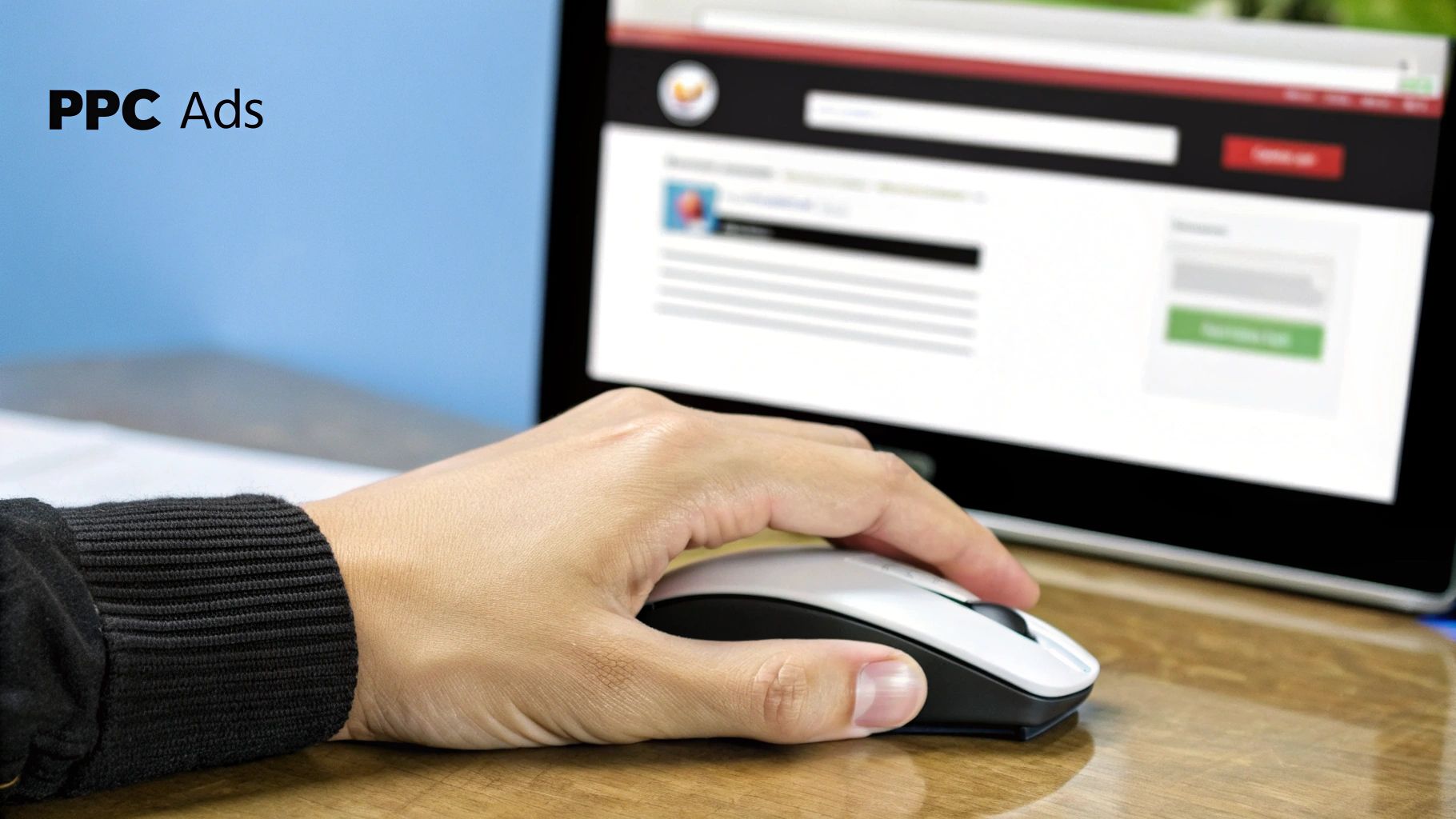
PPC advertising offers a variety of features to refine your targeting and maximize your return on investment. On Google Ads, you can target specific keywords relevant to your products. Social media platforms like Facebook, Instagram, and Pinterest allow you to target audiences based on demographics, interests, and even specific behaviors. Retargeting capabilities across these platforms let you re-engage visitors who have previously interacted with your store, such as those who abandoned their carts. Shopping ads, particularly effective on Google, display your product images and prices directly within search results. Finally, customizable budgets and bidding strategies give you granular control over your ad spend.
When and why to use PPC:
PPC is particularly effective when launching new products, running promotions, or targeting specific demographics or interests. If you need to quickly generate traffic and sales, PPC can deliver immediate results. It's also a great option for testing different product offerings and marketing messages.
Examples of Successful Implementation:
- MVMT Watches: Scaled to $90 million using Facebook and Instagram ads, demonstrating the power of social media advertising for e-commerce brands.
- Allbirds: Uses Google Shopping ads to capture high-intent traffic from users actively searching for shoes, showcasing the effectiveness of product-focused ads.
- Bombas: Effectively uses retargeting ads to recover abandoned carts, highlighting the potential of re-engaging potential customers who have shown initial interest.
Pros:
- Generates immediate traffic
- Highly targeted to reach specific audiences
- Scalable based on budget
- Detailed analytics and ROAS tracking
- Can test multiple ad variations quickly
Cons:
- Can be expensive, especially in competitive niches
- Requires ongoing investment
- Ad fatigue can occur without fresh creative
- Learning curve for optimization
- Ad blockers may reduce visibility
Actionable Tips for Shopify Store Owners:
- Start small: Begin with a small daily budget and gradually scale up based on performance.
- Use negative keywords (Google Ads): Prevent wasted spend by excluding irrelevant search terms.
- Dedicated landing pages: Create specific landing pages tailored to each ad campaign for a seamless user experience.
- Conversion tracking: Implement conversion tracking via the Shopify pixel to monitor the effectiveness of your ads.
- A/B testing: Regularly test different ad creatives and copy to optimize for higher click-through rates and conversions.
- Focus on ROAS: Prioritize Return on Ad Spend (ROAS) over Cost-Per-Click (CPC) to ensure profitability.
Experts to Learn From:
- Jon Loomer: Facebook ads expert
- Perry Marshall: Google Ads expert
- Ezra Firestone: Shopify store owner and ads expert
By following these tips and leveraging the power of PPC advertising, you can effectively drive targeted traffic to your Shopify store and achieve significant growth. Remember to continuously analyze your results and adapt your strategies to stay ahead of the curve.
4. Email Marketing
Email marketing is a powerful way to drive traffic to your Shopify store by building a list of interested prospects and customers, and sending targeted campaigns to bring them back to your site. This strategy encompasses various types of emails, including newsletters showcasing new products or company updates, promotional emails offering discounts and deals, abandoned cart emails reminding customers about items left in their cart, and post-purchase follow-ups encouraging repeat business and building customer loyalty. It's a direct line of communication to nurture leads and turn them into loyal customers.

Email marketing deserves its place on this list because it offers an incredibly high return on investment (ROI). Averaging $42 for every $1 spent, it outperforms most other digital marketing channels. Unlike social media platforms where algorithm changes can impact your reach, you own your email list. This control allows for highly personalized and targeted communication, fostering stronger customer relationships. Features like automated email sequences and personalized product recommendations make the process efficient and effective. For example, you can segment your list based on past purchases and send targeted emails featuring products they are likely to be interested in.
Examples of Successful Implementation:
- Brooklinen: Uses personalized product recommendation emails based on browsing history, enticing customers with items they've already shown interest in.
- Casper: Sends clever abandoned cart emails with customer reviews, leveraging social proof to encourage purchase completion.
- Beardbrand: Built their business through educational email content, establishing themselves as experts and building a loyal community.
Actionable Tips for Shopify Store Owners:
- Offer a discount code for first-time subscribers: Incentivize signup and capture leads.
- Segment your list based on purchase history and engagement: Send relevant content that resonates with specific customer groups.
- Create automated welcome sequences for new subscribers: Introduce your brand and nurture new leads.
- Send abandoned cart emails within 1-2 hours of abandonment: Strike while the iron is hot and recapture lost sales.
- Use compelling subject lines (30-50 characters optimal): Grab attention and increase open rates.
- Include user-generated content and reviews in emails: Build trust and social proof.
Pros and Cons of Email Marketing:
Pros:
- Highest ROI of digital marketing channels.
- You own the channel.
- Highly personalized and targeted communication.
- Automated sequences run 24/7.
- Builds long-term customer relationships.
Cons:
- Requires time to build a substantial list.
- Deliverability issues can occur.
- Email fatigue if sending too frequently.
- Needs continual list maintenance and cleaning.
- GDPR and other regulations require compliance.
When and Why to Use Email Marketing for Your Shopify Store:
Email marketing is essential for any Shopify store looking to drive consistent traffic and build a loyal customer base. Use it to promote new products, offer exclusive deals, recover abandoned carts, and stay top-of-mind with your customers. It's particularly effective for businesses with a strong focus on customer relationships and repeat purchases. Platforms like Klaviyo, popularized by figures like Ben Jabbawy (Founder of Privy) and Chase Dimond (email marketing consultant), are designed specifically for ecommerce and offer powerful tools to maximize your email marketing efforts. By implementing the tips above and staying consistent, you can leverage email marketing to significantly boost your Shopify store's traffic and revenue.
5. Content Marketing
Content marketing is a powerful way to drive organic traffic to your Shopify store. Instead of directly advertising your products, you're providing valuable and relevant content that attracts and engages your target audience. This could include blog posts, videos, buying guides, infographics, podcasts, and more. By establishing yourself as an authority in your niche, you build trust with potential customers and encourage them to visit your store. This strategy is a crucial component of any successful plan on how to drive traffic to Shopify store.
How it Works:
Content marketing works by attracting potential customers through valuable information related to your products. For example, if you sell hiking gear, you might create blog posts about popular hiking trails, gear reviews, or tips for beginners. This attracts people interested in hiking, who are then more likely to browse your products. By consistently providing helpful content, you build a loyal audience that sees you as a trusted resource, ultimately driving traffic and sales.
Examples of Success:
Several brands have effectively leveraged content marketing to drive massive growth. Beardbrand, for example, built a 7-figure business by creating educational content about beard care. Luxy Hair leveraged YouTube tutorials demonstrating how to use their hair extensions. Gymshark uses their blog to cover fitness topics, attracting their target audience and establishing their brand as a fitness authority. These examples show how valuable content can establish your brand and attract customers organically.
Actionable Tips:
- Keyword Research: Research keywords with commercial intent. For instance, if you sell coffee beans, target keywords like "best coffee beans for espresso" rather than just "coffee beans." This helps attract users actively looking to buy.
- Address Customer Pain Points: Create content that answers customer questions and solves their problems. This positions you as a helpful resource.
- Content Calendar: Develop a content calendar for consistent publishing. Regular updates keep your audience engaged and improve your SEO.
- Internal Linking: Include internal links to product pages where relevant within your content. This makes it easy for interested readers to purchase your products.
- Repurpose Content: Repurpose blog content into social media posts, email newsletters, and videos for wider reach.
- Use Content Tools: Leverage tools like BuzzSumo to find trending topics in your niche and tailor your content accordingly.
Pros and Cons:
Pros:
- Builds authority and trust in your niche.
- Supports SEO efforts with fresh content.
- Educates customers about your products.
- Can be repurposed across multiple channels.
- Provides long-term traffic (evergreen content).
Cons:
- Requires consistent content creation.
- Takes time to see significant results.
- Needs expertise or research in your niche.
- Content creation can be resource-intensive.
- Requires promotion to gain initial traction.
When and Why to Use Content Marketing:
Content marketing is ideal for long-term growth and building a sustainable brand. While it requires an upfront investment of time and resources, it can generate significant organic traffic over time, reducing reliance on paid advertising. If you're looking to establish your brand as a leader in your niche and attract customers organically, content marketing is a must.
Learn more about Content Marketing
Content marketing deserves its place on this list because it's a proven, effective, and sustainable way to drive traffic to your Shopify store. By providing value to your target audience, you build trust, improve SEO, and ultimately drive sales. It's a fundamental strategy for anyone learning how to drive traffic to Shopify store and achieving long-term success in e-commerce.
6. Influencer Marketing: Leverage Social Proof to Drive Shopify Traffic
Influencer marketing is a powerful strategy to drive traffic to your Shopify store by tapping into the established trust and reach of content creators within your niche. It's a proven method for how to drive traffic to Shopify store, especially when targeting specific demographics. This approach involves partnering with individuals who have a dedicated and engaged following on platforms like Instagram, TikTok, YouTube, or blogs. These influencers create authentic content showcasing your products and encouraging their audience to visit your store. Why does this deserve a spot on the list? Because it works. Influencer marketing leverages social proof and can introduce your brand to a highly targeted audience, leading to significant traffic increases and ultimately, boosted sales.
Here's how it works: You collaborate with influencers to feature your products in their content, be it a stylish Instagram post, an informative YouTube video, or a captivating blog review. They then direct their audience to your Shopify store through trackable links or unique discount codes. This allows you to measure the effectiveness of each campaign.
Features of Influencer Marketing:
- Partnerships with micro to macro influencers: From those with a few thousand followers (micro-influencers) to those with millions (macro-influencers), you can choose the level of reach that suits your budget and goals.
- Product seeding campaigns: Sending free products to influencers for honest reviews and potential features.
- Sponsored content creation: Paying influencers to create dedicated content highlighting your products.
- Affiliate partnerships with commission structures: Incentivizing influencers to drive sales by offering a percentage of each purchase made through their unique links.
- Influencer-specific discount codes: Providing influencers with unique discount codes to share with their followers, further incentivizing purchases and enabling accurate tracking.
Pros:
- Leverages established trust with targeted audiences: Influencers have already built rapport with their followers, making their recommendations more impactful than traditional advertising.
- Provides authentic product demonstrations: Influencers can showcase your products in real-life scenarios, demonstrating their value and usage.
- Creates content you can repurpose: You can often reuse influencer-generated content on your own social media channels and website.
- Reaches niche communities effectively: Influencer marketing allows you to pinpoint specific demographics interested in your products.
- Can generate immediate traffic spikes: A well-executed influencer campaign can result in a noticeable surge in website visits and sales.
Cons:
- Can be expensive for larger influencers: Collaborating with celebrities or macro-influencers can require a significant budget.
- Results can be unpredictable: The success of a campaign depends on various factors, including the influencer's authenticity and audience engagement.
- Finding the right influencers takes time: Research and vetting potential influencers is crucial for successful partnerships.
- Some influencers have fake or low-engagement followers: It’s essential to analyze influencer metrics carefully to avoid fraudulent accounts.
- Measuring exact ROI can be challenging: While tracking links and discount codes provide data, attributing every sale solely to influencer marketing can be difficult.
Examples of Successful Influencer Marketing:
- Daniel Wellington: This watch brand built its empire primarily through Instagram influencer marketing, showcasing their products on the wrists of stylish individuals.
- Fashion Nova: This fast-fashion retailer partners with thousands of micro-influencers for consistent exposure and brand awareness.
- Gymshark: Their athlete program, partnering with fitness influencers, drove massive growth and established the brand as a fitness apparel leader.
Tips for Effective Influencer Marketing on Shopify:
- Focus on engagement rates rather than follower count: A smaller, highly engaged audience is often more valuable than a large, passive one.
- Start with micro-influencers (10K-50K followers) for better ROI: Micro-influencers are often more affordable and have a higher level of engagement with their audience.
- Provide unique tracking links or discount codes to measure performance: This allows you to track the traffic and sales generated by each influencer.
- Build long-term relationships rather than one-off campaigns: Ongoing partnerships foster deeper trust and yield better results over time.
- Allow creative freedom while providing clear guidelines: Influencers know their audience best. Give them room to create authentic content while ensuring your brand message is conveyed.
- Look for influencers whose audience matches your target demographic: Alignment between the influencer's audience and your target market is crucial for campaign success.
By following these tips and learning from successful examples, you can harness the power of influencer marketing to effectively drive traffic to your Shopify store and achieve your business goals. This method provides a direct line to engaged consumers, offering a valuable addition to your overall marketing strategy when considering how to drive traffic to Shopify store.
7. Conversion Rate Optimization (CRO)
Driving traffic to your Shopify store is crucial, but what happens when visitors arrive and don't buy anything? That's where Conversion Rate Optimization (CRO) comes in. This powerful strategy focuses on turning existing visitors into paying customers, making the most of your marketing efforts and boosting your bottom line. It's an essential element in any successful strategy for how to drive traffic to Shopify store, because it helps you maximize the value of that traffic.
CRO works by enhancing every aspect of your store that influences a customer's decision to purchase. This includes improving user experience, simplifying the checkout process, building trust, and creating a sense of urgency. Instead of focusing on attracting more visitors, CRO concentrates on getting more out of the visitors you already have. Essentially, it's about optimizing your Shopify store to make it easier and more enticing for visitors to convert into buyers.
Here's how CRO can help you drive traffic to Shopify store more effectively: by increasing the return on investment from your existing traffic generation strategies. When your conversion rate is higher, each visitor becomes more valuable, meaning your marketing spend goes further. This allows you to reinvest your profits into acquiring even more targeted traffic, creating a positive feedback loop for growth.
Successful examples of CRO in action abound:
- Casper: Showcased customer reviews prominently on product pages, building trust and driving conversions.
- Allbirds: Streamlined their checkout process, minimizing friction and reducing cart abandonment rates.
- Bombas: Enhanced product photography and sizing guides, giving customers the confidence to purchase.
Want to implement CRO in your own Shopify store? Here are some actionable tips:
- Analyze Data: Dive into your Google Analytics to identify drop-off points in the customer journey. Where are people leaving your site?
- Heatmaps: Utilize heat mapping tools to visualize how visitors interact with your pages. This can reveal areas of interest and potential usability issues.
- A/B Testing: Test one element at a time (headlines, images, button colors, etc.) to isolate the impact of each change.
- Mobile-First: Optimize for mobile users. They often represent over 50% of traffic.
- Trust Signals: Add security badges and customer reviews near the checkout to build trust and reduce purchase anxiety.
- Exit-Intent Popups: Implement exit-intent popups to offer discounts or incentives to visitors who are about to leave.
- Simplify Checkout: Reduce form fields in the checkout process to the bare minimum required.
Learn more about Conversion Rate Optimization (CRO)
Pros:
- Increased revenue without necessarily needing more traffic.
- Improved ROI on all marketing channels.
- Better customer experiences.
- Data-driven insights for continuous improvement.
- Smaller investment compared to new traffic acquisition.
Cons:
- Requires existing traffic to test effectively.
- Can be technically complex to implement fully.
- Needs ongoing testing and refinement.
- Might require developer assistance for some changes.
- Benefits are incremental rather than immediate.
CRO has been popularized by experts like Peep Laja (founder of CXL), sophisticated Shopify Plus merchants, and UX research organizations like the Baymard Institute. By focusing on optimizing your store for conversions, you're not just driving traffic; you're building a sustainable engine for growth and profitability. This is why CRO deserves a prominent place in any list of strategies for how to drive traffic to Shopify store: it multiplies the value of every visitor you attract.
8. Affiliate Marketing: Leverage Others to Drive Traffic to Your Shopify Store
Affiliate marketing is a powerful way to drive targeted traffic to your Shopify store by leveraging the reach and influence of others. It's a performance-based marketing strategy where you recruit partners (affiliates) to promote your products. These affiliates earn a commission for every sale they generate through unique tracking links. This method deserves a spot on this list because it offers scalable growth potential with minimal upfront investment, tapping into pre-existing audiences and only paying for results. It's particularly effective for Shopify stores because of the platform's built-in capabilities and the availability of numerous affiliate marketing apps.
How Affiliate Marketing Works:
- Recruitment: You find and recruit affiliates relevant to your niche. These could be bloggers, influencers, YouTubers, or even other businesses.
- Unique Links: Each affiliate receives a unique tracking link that identifies the traffic they send to your store.
- Promotion: Affiliates promote your products through their websites, social media channels, email lists, or other platforms.
- Tracking: When a customer clicks on an affiliate's link and makes a purchase on your Shopify store, the sale is tracked back to that affiliate.
- Commission: You pay the affiliate a pre-agreed commission for the sale.
Features of Effective Affiliate Programs:
- Commission-based Payment: You only pay when a sale is made, making it a cost-effective strategy.
- Tracking Links and Cookies: Accurate tracking ensures affiliates get credited for their referrals.
- Tiered Commission Options: Incentivize top performers with higher commission rates.
- Affiliate Dashboards and Reporting: Provide affiliates with access to performance data and resources.
- Promotional Materials for Affiliates: Equip affiliates with ready-made banners, product images, and copy.
Pros of Affiliate Marketing:
- Pay for Performance: You only pay for actual sales (Cost Per Acquisition model).
- Scalability: Expand your reach without significant upfront investment.
- Content Creation and Promotion: Affiliates handle the marketing efforts, saving you time and resources.
- New Audiences: Tap into established audiences through trusted sources.
- Automation: Streamline the process with affiliate marketing software.
Cons of Affiliate Marketing:
- Recruitment Time: Finding quality affiliates takes time and effort.
- Commission Costs: Commissions can impact profit margins.
- Relationship Management: Maintaining strong affiliate relationships requires ongoing communication.
- Potential for Questionable Tactics: Some affiliates may resort to spam or misleading practices.
- Tracking Complexity: Implementing tracking can be technically challenging.
Examples of Successful Affiliate Programs:
- Bluehost: Their affiliate program pays $65+ per signup and is a significant driver of new customers.
- GoPro: Leverages content creators to showcase their products in action, driving both traffic and brand awareness.
- Wayfair: Built a large affiliate network of home decor bloggers and influencers to reach a targeted audience.
Tips for Running a Successful Affiliate Program for Your Shopify Store:
- Competitive Commission Rates: Offer attractive commissions (typically 10-30% for physical products).
- Provide Creative Assets: Equip affiliates with high-quality banners, images, and product descriptions.
- Dedicated Affiliate Page: Create a page on your website with program details and signup information.
- Niche Targeting: Focus on recruiting affiliates within your specific niche to reach the most relevant audience.
- Tiered Commissions: Reward top performers with higher commission rates to incentivize growth.
- Clear Terms and Conditions: Protect your brand by establishing clear guidelines for affiliate behavior.
- Regular Communication: Keep affiliates informed about new products, promotions, and program updates.
Popularized By:
- Amazon Associates: One of the pioneering and most successful affiliate programs.
- Pat Flynn (Smart Passive Income): A prominent figure in the affiliate marketing world.
- ShareASale and Commission Junction: Large affiliate networks connecting merchants with potential affiliates.
By strategically implementing an affiliate program, you can effectively drive targeted traffic to your Shopify store, boost sales, and expand your brand's reach while leveraging the power of partnerships. This method is particularly valuable when you're looking for cost-effective, scalable growth and are willing to invest the time in nurturing affiliate relationships. It's an excellent way to expand your marketing efforts beyond traditional advertising and tap into the influence of trusted sources within your niche. Remember to track your results and adjust your strategy as needed to maximize the impact of your affiliate marketing program.
8 Strategies Traffic Drive Comparison
| Strategy | Implementation Complexity 🔄 | Resource Requirements ⚡ | Expected Outcomes 📊 | Ideal Use Cases 💡 | Key Advantages ⭐ |
|---|---|---|---|---|---|
| Search Engine Optimization (SEO) | Medium – requires ongoing effort and technical knowledge | Moderate – tools and content creation | Sustainable long-term traffic, improved rankings | Stores targeting high purchase intent, long-term growth | High ROI, builds credibility, targets organic search traffic |
| Social Media Marketing | High – consistent content creation and platform management | High – content production and community management | Brand awareness, engagement, viral potential | Visual products, younger demographics, community building | Builds brand loyalty, direct engagement, viral reach |
| Pay-Per-Click (PPC) Advertising | Medium – requires campaign setup and optimization | High – requires budget for ads | Immediate, targeted traffic and quick results | Quick traffic boost, testing ads, scalable campaigns | Immediate traffic, highly targeted, measurable ROI |
| Email Marketing | Medium – requires list building and automation setup | Moderate – email platform and content | High ROI, repeat purchases, customer retention | Customer retention, personalized marketing | Highest ROI, owns communication channel, automated |
| Content Marketing | High – needs consistent creation and SEO integration | High – skilled content creation needed | Long-term traffic, authority building | Educating customers, supporting SEO, brand authority | Builds trust, supports SEO, repurposable content |
| Influencer Marketing | Medium to High – managing partnerships and campaigns | Moderate to High – influencer fees and tracking | Immediate spikes in traffic, brand credibility | Niche communities, social proof, brand endorsements | Authentic content, trusted recommendations, niche reach |
| Conversion Rate Optimization (CRO) | Medium to High – technical setup for testing and UX tweaks | Moderate – tools and sometimes dev support | Incremental revenue increase without more traffic | Improving existing traffic conversion, checkout optimization | Improves ROI on all channels, data-driven, enhances UX |
| Affiliate Marketing | Medium – setup tracking and manage relationships | Moderate – commissions and management | Performance-based sales, scalable with affiliates | Expanding reach through trusted partners | Pay for performance, scalable, new audience access |
Turning Traffic into Triumph: Maximizing Your Shopify Success
Driving targeted traffic to your Shopify store is the lifeblood of your online business. We've explored a range of powerful strategies in this article, from leveraging the organic reach of Search Engine Optimization (SEO) and Content Marketing to harnessing the targeted power of Pay-Per-Click (PPC) advertising and Social Media Marketing. We also touched on the importance of Influencer Marketing, Affiliate Marketing, and Email Marketing to broaden your reach and connect with potential customers. Remember, it's not just about quantity, but quality. That's where Conversion Rate Optimization (CRO) comes into play, ensuring your visitors have a smooth, engaging experience that encourages them to convert into paying customers. Mastering these approaches is key to not only driving traffic but also building a thriving, profitable online presence.
By implementing these strategies effectively, you can transform your Shopify store from a simple online storefront into a powerful engine for growth. This translates to increased brand visibility, a larger customer base, and ultimately, higher sales and revenue. The more you refine your approach to how to drive traffic to your Shopify store, the more successful your ecommerce venture will become.
Want to streamline your social media traffic and make it easier for customers to find your products? Centralize your marketing efforts with LinkShop and create a powerful, shoppable link in bio for platforms like Instagram and TikTok, guiding your hard-earned traffic directly to your Shopify store. Explore the potential of LinkShop today and transform your social media presence into a sales powerhouse: LinkShop
